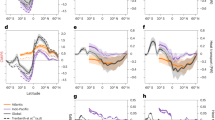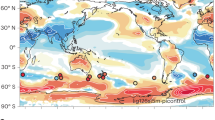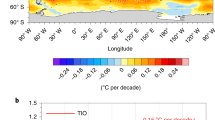Abstract
Thermal expansion of the ocean in response to warming is an important component of historical sea-level rise1. Observational studies show that the Atlantic and Southern oceans are warming faster than the Pacific Ocean2,3,4,5. Here we present simulations using a numerical atmospheric-ocean general circulation model with an interactive carbon cycle to evaluate the impact of carbon emission rates, ranging from 2 to 25 GtC yr−1, on basin-scale ocean heat uptake and sea level. For simulations with emission rates greater than 5 GtC yr−1, sea-level rise is larger in the Atlantic than Pacific Ocean on centennial timescales. This basin-scale asymmetry is related to the shorter flushing timescales and weakening of the overturning circulation in the Atlantic. These factors lead to warmer Atlantic interior waters and greater thermal expansion. In contrast, low emission rates of 2 and 3 GtC yr−1 will cause relatively larger sea-level rise in the Pacific on millennial timescales. For a given level of cumulative emissions, sea-level rise is largest at low emission rates. We conclude that Atlantic coastal areas may be particularly vulnerable to near-future sea-level rise from present-day high greenhouse gas emission rates.
This is a preview of subscription content, access via your institution
Access options
Subscribe to this journal
Receive 12 print issues and online access
$259.00 per year
only $21.58 per issue
Buy this article
- Purchase on Springer Link
- Instant access to full article PDF
Prices may be subject to local taxes which are calculated during checkout




Similar content being viewed by others
References
Church, J. A. et al. in Climate Change 2013: The Physical Science Basis (eds Stocker, T. et al.) 1137–1216 (IPCC, Cambridge Univ. Press, 2013).
Carton, J. A. & Santorelli, A. Global decadal upper-ocean heat content as viewed in nine analyses. J. Clim. 21, 6015–6035 (2008).
Purkey, S. G. & Johnson, G. C. Warming of global abyssal and deep southern ocean waters between the 1990s and 2000s: contributions to global heat and sea level rise budgets. J. Clim. 23, 6336–6351 (2010).
Levitus, S. et al. World ocean heat content and thermosteric sea level change (0–2000 m), 1955–2010. Geophys. Res. Lett. 39, L10603 (2012).
Robson, J., Sutton, R., Lohmann, K., Smith, D. & Palmer, M. D. Causes of the rapid warming of the North Atlantic Ocean in the mid-1990s. J. Clim. 25, 4116–4134 (2012).
Solomon, S., Plattner, G.-K., Knutti, R. & Friedlingstein, P. Irreversible climate change due to carbon dioxide emissions. Proc. Natl Acad. Sci. USA 106, 1704–1709 (2009).
Ciais, P. et al. in Climate Change 2013: The Physical Science Basis (eds Stocker, T. et al.) 465–570 (IPCC, Cambridge Univ. Press, 2013).
Rhein, M. et al. in Climate Change 2013: The Physical Science Basis (eds Stocker, T. et al.) 255–316 (IPCC, Cambridge Univ. Press, 2013).
Chen, X. & Tung, K.-K. Varying planetary heat sink led to global-warming slowdown and acceleration. Science 345, 897–903 (2014).
Meehl, G. A., Arblaster, J. M., Fasullo, J. T., Hu, A. & Trenberth, K. E. Model-based evidence of deep-ocean heat uptake during surface-temperature hiatus periods. Nature Clim. Change 1, 360–364 (2011).
Krasting, J. P., Dunne, J. P., Shevliakova, E. & Stouffer, R. J. Trajectory sensitivity of the transient climate response to cumulative carbon emissions. Geophys. Res. Lett. 41, 2520–2527 (2014).
Thiele, G. & Sarmiento, J. L. Tracer dating and ocean ventilation. J. Geophys. Res. 95, 9377–9391 (1990).
Stouffer, R. J. & Manabe, S. Response of a coupled ocean–atmosphere model to increasing atmospheric carbon dioxide: sensitivity to the rate of increase. J. Clim. 12, 2224–2237 (1999).
Myhre, G., Highwood, E. J., Shine, K. P. & Stordal, F. New estimates of radiative forcing due to well mixed greenhouse gases. Geophys. Res. Lett. 25, 2715–2718 (1998).
Matthews, H. D., Gillett, N. P., Stott, P. A. & Zickfeld, K. The proportionality of global warming to cumulative carbon emissions. Nature 459, 829–832 (2009).
Stouffer, R. J. Time scales of climate response. J. Clim. 17, 209–217 (2004).
Griffies, S. M. et al. An assessment of global and regional sea level for years 1993–2007 in a suite of interannual CORE-II simulations. Ocean Model. 78, 35–89 (2014).
Manabe, S. & Stouffer, R. J. Simulation of abrupt climate change induced by freshwater input to the North Atlantic Ocean. Nature 378, 165–167 (1995).
Yin, J. Century to multi-century sea level rise projections from CMIP5 models. Geophys. Res. Lett. 39, L17709 (2012).
Bilbao, R. F., Gregory, J. & Bouttes, N. Analysis of the regional pattern of sea level change due to ocean dynamics and density change for 1993–2099 in observations and CMIP5 AOGCMs. Clim. Dynam. 45, 2647–2666 (2015).
Levermann, A., Griesel, A., Hofmann, M., Montoya, M. & Rahmstorf, S. Dynamic sea level changes following changes in the thermohaline circulation. Clim. Dynam. 24, 347–354 (2005).
Kuhlbrodt, T. & Gregory, J. M. Ocean heat uptake and its consequences for the magnitude of sea level rise and climate change. Geophys. Res. Lett. 39, L18608 (2012).
Horton, R. et al. in Climate Change Impacts in the United States: The Third National Climate Assessment (eds Melillo, J. M., Richmond, T. T. & Yohe, G. W.) Ch. 16 (US Global Change Research Program, 2014).
Taylor, K. E., Stouffer, R. J. & Meehl, G. A. An overview of CMIP5 and the experiment design. Bull. Am. Meteorol. Soc. 93, 485–498 (2011).
Delworth, T. L. et al. GFDL’s CM2 global coupled climate models. Part I: Formulation and simulation characteristics. J. Clim. 19, 643–674 (2006).
Shevliakova, E. et al. Carbon cycling under 300 years of land use change: importance of the secondary vegetation sink. Glob. Biogeochem. Cycles 23, GB2022 (2009).
Dunne, J. P. et al. GFDL’s ESM2 global coupled climate–carbon earth system models. Part I: Physical formulation and baseline simulation characteristics. J. Clim. 25, 6646–6665 (2012).
Johns, W. E. et al. Continuous, array-based estimates of Atlantic Ocean heat transport at 26.5° N. J. Clim. 24, 2429–2449 (2010).
Dunne, J. P. et al. GFDL’s ESM2 global coupled climate–carbon earth system models. Part II: Carbon system formulation and baseline simulation characteristics. J. Clim. 26, 2247–2267 (2013).
Vuuren, D. et al. The representative concentration pathways: an overview. Climatic Change 109, 5–31 (2011).
Acknowledgements
We thank A. Adcroft and K. Dixon for their comments and feedback on this study. We also thank C. Raphael for assistance in preparing the figures for this manuscript.
Author information
Authors and Affiliations
Contributions
J.P.K. designed the study and conducted the experiments. J.P.K. and J.P.D. performed the analysis of the results. All authors contributed to the interpretation of the results and assisted in writing the manuscript.
Corresponding author
Ethics declarations
Competing interests
The authors declare no competing financial interests.
Supplementary information
Supplementary Information
Supplementary Information (PDF 905 kb)
Rights and permissions
About this article
Cite this article
Krasting, J., Dunne, J., Stouffer, R. et al. Enhanced Atlantic sea-level rise relative to the Pacific under high carbon emission rates. Nature Geosci 9, 210–214 (2016). https://doi.org/10.1038/ngeo2641
Received:
Accepted:
Published:
Issue Date:
DOI: https://doi.org/10.1038/ngeo2641
This article is cited by
-
Will They Stay or Will They Go — Understanding South Atlantic Coastal Wetland Transformation in Response to Sea-Level Rise
Estuaries and Coasts (2023)
-
Effect of different factors dominated by water level environment on wetland carbon emissions
Environmental Science and Pollution Research (2022)
-
Evolving patterns of sterodynamic sea-level rise under mitigation scenarios and insights from linear system theory
Climate Dynamics (2021)
-
Challenges and Directions for the Advancement of Estuarine Ecosystem Science
Ecosystems (2017)



